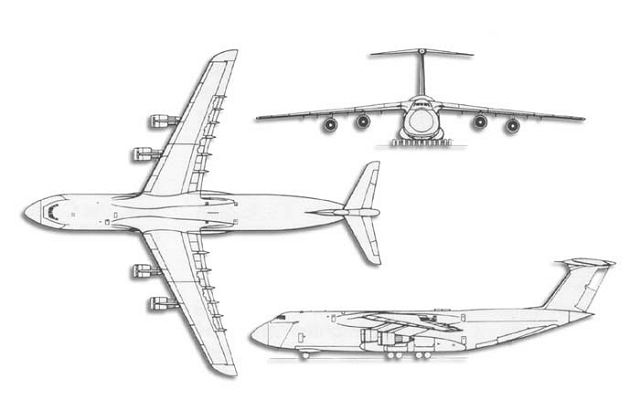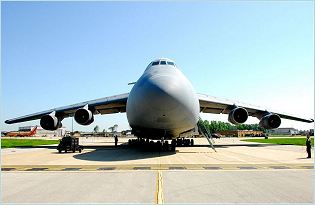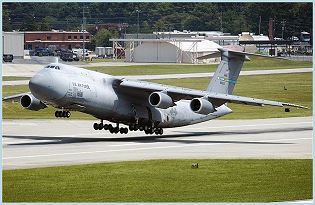C-5 Galaxy
| a | ||||||||||||||||||||||
|
C-5 Galaxy strategic military transport aircraft
|
||||||||||||||||||||||
 |
||||||||||||||||||||||
|
|
||||||||||||||||||||||
|
The C-5 Galaxy is a large military transport aircraft designed, developed and manufactured by the American Company Lockheed. To meet a USAF Military AirTransport Service (MATS) requirement for a very large strategic transport to complement the Lockheed C-141, and with the ability to operate from the same airfields, Lockheed's design proposal was selected in October 1965, to be powered by a new General Electric turbofan engine for which a development contract had been placed two months earlier. Construction of the prototype began in August 1966, by which time the aircraft had been designated Lockheed C-5A Galaxy, and this flew for the first time on 30 June 1968. The first operational example was delivered to Military Airlift Command (MAC) on 17 December 1969 and a total of 81 were built to equip four squadrons. The C-5 Galaxy is capable of carrying nearly every type of the Army's combat equipment, including bulky items such as the 74 short tons (67 t) armored vehicle launched bridge (AVLB), from the United States to any location on the globe. A C-5 is capable of transporting up to six Boeing AH-64 Apaches or five Bradley Fighting Vehicles. The C-5 Galaxy is one of the largest aircraft in the world and the largest airlifter in the United States Air Force inventory. The aircraft can carry a fully equipped combat-ready military unit to any point in the world on short notice and then provide the supplies required to help sustain the fighting force. |
||||||||||||||||||||||
| Main variants: | ||||||||||||||||||||||
|
- C-5A: The C-5A is the original version of the C-5.
- C-5B: is an improved version of the C-5A. It incorporated all modifications and improvements made to the C-5A with improved wings, simplified landing gear, upgraded TF-39-GE-1C turbofan engines and updated avionics. - C-5C: is a specially modified variant for transporting large cargo. - C-5M Super Galaxy: equipped with Avionics Modernization Program (AMP) began in 1998 and includes upgrading avionics to Global Air Traffic Management compliance, improving communications, new flat panel displays, improving navigation and safety equipment, and installing a new autopilot system. New General Electric F138-GE-100 (CF6-80C2) engines, pylons and auxiliary power units, upgrades to aircraft skin and frame, landing gear, cockpit and pressurization systems |
||||||||||||||||||||||
| Technical Data | ||||||||||||||||||||||
| Design | ||||||||||||||||||||||
|
The C-5 Galaxy is similar in configuration to the C-141 StarLifter, although very much larger and with a lower deck that has an unobstructed length of 36.91 m and width of 5.79 m, it has in addition forward loading capability, via a visor type upward-hinged nose. It also has 28 wheeled retractable landing gear, to cater for operations with heavy loads from unpaved surfaces, each wheel-bogie having a shock-strut that can be shortened on the ground to simplify loading and unloading. It has an upper deck seating area for 73 passengers and two loadmasters. The passengers face the rear of the aircraft, rather than forward. Its takeoff and landing distances, at maximum gross weight, are 2,500 m and 1,500 m respectively
|
||||||||||||||||||||||
| Avionics | ||||||||||||||||||||||
|
The C-5 Galaxy has sophisticated communications equipment and a triple inertial navigation system (INS), making it nearly self-sufficient. It can operate without using ground-based navigational aids. Under the Pacer Snow project, two C-5s received installation of ALE-40 flare dispensers and an AAR-47 missile warning system to provide a measure of self-defense. An automatic trouble-shooting system constantly monitors more than 800 test points in the various subsystems of the aircraft. The Malfunction Detection Analysis and Recording System (MADAR) use a digital computer to identify malfunctions in replaceable units. Failure and trend information is recorded on magnetic tape for analysis.
|
||||||||||||||||||||||
| Propulsion | ||||||||||||||||||||||
|
The C-5 Galaxy military transport aircraft is powered by four GE TF39GE-1C turbofan engines, each providing 191kN. The aircraft is also equipped with a Hamilton Sundstrand auxiliary power unit.
|
||||||||||||||||||||||
| Capabilies | ||||||||||||||||||||||
|
The C-5 has a greater capacity than any other airlifter. It has the ability to carry 36 standard pallets and 81 troops simultaneously. The Galaxy is also capable of carrying any of the Army's air-transportable combat equipment, including such bulky items as the 74-ton mobile scissors bridge. It can also carry outsize and oversize cargo over intercontinental ranges and can take off or land in relatively short distances. Ground crews are able to load and off-load the C-5 simultaneously at the front and rear cargo openings, reducing cargo transfer times. Other features of the C-5 are:
· Able to operate on runways 6,000 feet long (1,829 meters). · Five landing gear totaling 28 wheels to distribute the weight. · Nose and aft doors that open the full width and height of the cargo compartment to permit faster and easier loading. · A "kneeling" landing gear system that permits lowering the parked aircraft to facilitate drive-on/drive-off vehicle loading and adjusts the cargo floor to standard truck-bed height. · Full width drive-on ramps at each end for loading double rows of vehicles. · A maintenance diagnostics system that records and analyzes data from more than 800 (C-5A) and 7000 (C 5M) test points so that maintenance repair time is reduced. |
||||||||||||||||||||||
| Specifications | ||||||||||||||||||||||
|
||||||||||||||||||||||
 |
||||||||||||||||||||||
|
||||||||||||||||||||||
|
a a
|
||||||||||||||||||||||































